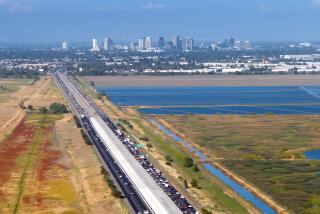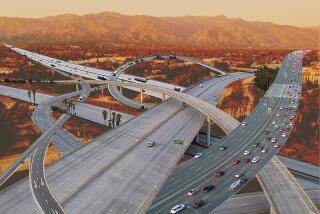Gasoline Pricing Involves Marketing to the Nth Degree
- Share via
Dear Street Smart:
My question pertains to the everyday driving of our automobiles, but not to any particular hazardous or unusual traffic conditions that might exist. What has puzzled me for many years is why the price of the gasoline that we purchase at our filling stations always ends in nine-tenths of one cent.
No matter which grade of gasoline is purchased, or whether overall prices fluctuate up or down, they always end in nine-tenths of a cent.
This seems awkward. Why not just round off to the nearest cent? Can you help me with this question and any logic that may be involved?
Joseph J. Kertesz, Huntington Beach
*
Your observation is absolutely correct, according to Trilby Lundberg, publisher of a newsletter called the Lundberg Letter, which tracks gasoline prices throughout the country.
In response to a similar question a few years ago, her newsletter surveyed the pricing practices of gasoline dealers nationwide. The results: The overwhelming majority of dealers price their gasoline at the nine-tenths of a cent per gallon rather than rounding it up to the next whole cent. The second most popular fraction is seven-tenths, she said, followed by five-tenths.
“Odd numbers seems to be more popular than even numbers,” Lundberg said.
She theorizes that the practice evolved along with similar habits in other areas of retail.
“In retailing, in general, it does seem that there are lots of 99-cent sales whether it’s cars, shoes, sunglasses or gas,” Lundberg said. “I would infer that the practice presumes that customers enjoy seeing a number that looks a little lower than the number that it’s really close to.”
Others agree.
“Historically speaking, $2.99 sounds less than $3,” said Jan Speelman, executive director of the Automotive Trade Organization of California, an Irvine-based group representing 1,200 gasoline retailers statewide. “Originally, it was a marketing decision made by the oil companies.”
Speelman said she isn’t aware of specifically how or when the practice began. But in the modern computer age, she said, it has been somewhat institutionalized by the use of automatic fuel pumps.
“The pumps are programmed now,” Speelman said. When dealers get notice of a petroleum company price increase, she said, “in many cases, they simply punch the price in and the software makes the adjustments. It ends up at [nine-tenths] because the pumps are programmed that way.”
****
Dear Street Smart:
Why is it, in a land where courtesy of the road is a thing of the past and contempt for the law seems to be at an all-time high, that the traffic on the freeway comes to a virtual halt when there is police action on the side of the freeway?
Does the traffic slow down out of respect for the rotating beacons on the California Highway Patrol cars? Of course not! We know that there is always the possibility of lots of blood and gore, and in the hope of being able to say “I was there, I saw it!” the inevitable slowdown occurs.
There are two possible solutions:
1. Have the CHP cars fitted with electric signs saying “follow me” and simply have these cars leave the freeway at the first offramp, thus doing their work out of sight.
2. Erect privacy screens or walls along the right-hand shoulder of the freeway at one-quarter-mile intervals. When an offending motorist is guided to one of the shelters, the traffic will not be interrupted by the “gapers.”
Don Dunkleman, Orange
*
As to why rubbernecking occurs, you’ve answered your own rhetorical question, according to Steve Kohler, a spokesman for the California Highway Patrol.
“Any time you get anything happening out of the ordinary,” he said, “people gawk. I think it’s human nature. Maybe it’s just people saying, ‘Geez, I’m glad I’m not the guy who got stopped.’ ”
Kohler doesn’t like your proposed solutions, however.
The first one, he said, would simply not work in most situations. “Obviously, we want to avoid congestion too,” Kohler said, “but it would be impractical to take every traffic enforcement stop off the freeway. The officer has to pick a location that he feels is appropriate and safe. Would you want to have someone following you three miles to the next offramp and then have to look for a place to park?”
Kohler objects to your second suggestion--erecting freeway “privacy screens”--on the basis of cost. But Jim Drago, a spokesman for Caltrans, has an even more immediate concern.
“What you’d have is an added impediment that someone could hit,” he said. “What if you lose your bearings and start to drift over--you’re going to run into that wall. In your effort to solve one problem, you’d be potentially creating an even worse problem.”
Both men agree on a simple solution to the rubbernecking problem.
“Keep your eyes on the road ahead and not on what’s happening on the shoulder,” Kohler said.
****
Dear Street Smart:
Is it not still a Vehicle Code violation to drive with only the parking lights lit at any time during the day or night? How do the new “daytime headlamps” fit in with this restriction?
John P. McCarthy, Aliso Viejo
Parking lights are just what their name implies, according to Kohler: for parking only. Low-voltage lights designed to make your car more visible while parked, they should not be left on at any other time.
“Those are parking lights, not driving lights,” he said, adding that motorists caught driving with their parking lights on will be cited.
Daytime running lights, however, are another thing entirely. Installed in some newer cars to make them more visible in daytime traffic, daytime running lights are different from regular headlights and go on automatically each time the vehicle is driven.
While the CHP has taken no position on daytime running lights, Kohler said, the lights are perfectly legal and, according to some studies, help prevent accidents.
****
A survey by the Orange County Transportation Authority shows that 62% of those asked said that they “strongly approve” of carpool lanes. Not yet released by OCTA is the percentage of respondents willing to pay for the privilege of using such lanes without car-pooling. The $50,000 study was commissioned by the transportation agency to gauge public response to the idea of high-occupancy toll lanes in Orange County--lanes that are free to car-poolers, but cost everyone else a toll.






